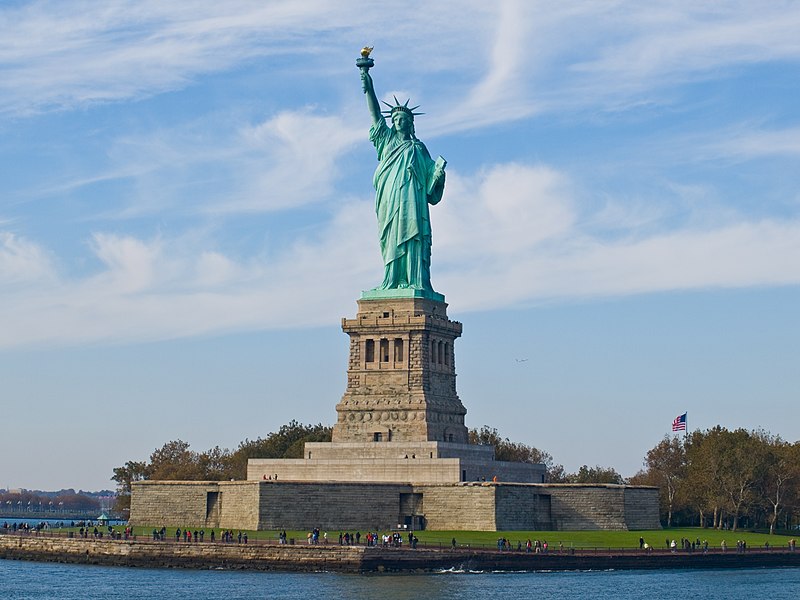 |
| Unpacking the head of the Statue of Liberty June 17, 1885 |
The story of the Statue of Liberty is the story of the difference one determined person can make... with a little help from his friends.
In 1865, Frédéric-Auguste Bartholdi, a young French sculptor, went to a banquet near the town of Versailles and got into a conversation with Edouard de Laboulaye, a prominent historian. De Laboulaye was a great admirer of the United States and observed that the country's centennial was approaching in 1876. He proposed that France should give America a gift to celebrate the occasion. But what? Bartholdi proposed a giant statue of some kind ... and thought about it for the next six years.
By 1871, Bartholdi had worked out most of the details in his mind: The American monument would be a colossal statue of a woman called "Liberty Enlightening the World" paid for by the French people. The people of America would finance the pedestal that it stood on.
 |
| Photo credit: http://www.neatorrama.com Illustration from U.S. Patent D11023, Filed Jan 2, 1870. |
Even though it soon became evident that he could not design, build, ship and install the statue in time for America's Centennial, which was now just 2 years away, he kept working. In 1880 the Franco-American Union came up with the idea of holding a Liberty Lottery to raise the $400,000.00 he needed to complete his work. The French were enthusiastic. The American's not so much. Some openly wondered if America needed a French statue... even if it was free.
 |
| Photo credit: http://www.neatorama.com Left: The Statue of Liberty being built in Bartholdi's studio. Right: The head of the statue on exhibit at the 1878 Paris Exposition. |
By now, the Statue of Liberty's right hand and torch were finished, so Bartholdi shipped it to the Philadelphia Centennial Exhibition and had it put on display. For a fee of 50 cents, visitors could climb a 30-foot steel ladder up the side of the hand and stand on the balcony surrounding the torch. Two years later the statue's head was displayed in a similar fashion in Paris, giving people a chance to climb up into the head and peek out from the windows in the crown. But while events like these generated a lot of enthusiasm, they didn't raise as much money as Bartholdi hoped for. In 1883 Congress again voted down funding $100,000 toward the cost of the pedestal. Joseph Pulitzer, publisher of the New York World, found that so outrageous that he launched a campaign in the pages of his newspaper to raise the money. "The Bartholdi statue will soon be on its way to enlighten the world," he told his readers, "more appropriate would be the gift of a statue of parsimony than a statue of liberty, if this is the appreciation we show of a friendly nation's sentiment and generosity." After two months of non-stop haranguing, he managed to raise exactly $135.75 of the $200,000 needed to build the pedestal.
The statue was finished and standing in the courtyard of Bartholdi's studio awaiting shipment to the U.S. In September 1884 work on the pedestal ground to a halt when the project ran out of money. An estimated $100,000 was still needed. When it appeared that New York was coming up empty-handed, Boston, Cleveland, Philadelphia, and San Francisco began to compete to have the Statue of Liberty built in their cities. Furious, Joseph Pulitzer decided to try again. Appealing to the now larger readership of his newspaper, he said "The statue is not a gift from the millionaires of France to the millionaires of America, but a gift of the whole people of France to the whole people of America. Take this appeal to yourself personally." This time he got results and work was begun again on the pedestal. On April 1, Pulitzer announced that the ship containing the crated parts of the statue would leave France aboard the French warship Isere on May 8th. The excitement began to build, prompting a new wave of giving. The race to fund the pedestal captivated the entire country, and money really began to pour in. People sent in pennies, nickels and dimes ... and they also began buying copies of the World each day to keep track of the race; by the time the dust settled, the World's circulation had exploded to the point that it was the most widely-read newspaper in the entire Western hemisphere. On June 19, the fundraising passed the $75,000 mark; on July 22, the Isere arrived in New York Harbor and began unloading its cargo; bringing the excitement - and the giving - to its peak. Finally on August 11, Pulitzer's goal was met. The headline read: "ONE HUNDRED THOUSAND DOLLARS! TRIUMPHANT COMPLETION OF THE WORLD'S FUND FOR THE LIBERTY PEDESTAL." More than 120,000 people had contributed to the effort, for an average donation of about 83¢ per person. Work on the pedestal now moved at a steady clip; by April 1886 it was finished, and the pieces of the statue itself were put into place. The internal steel and iron framework structure went up first; then the pieces of the statue's outer skin were attached one by one.
Finally on October 28, 1886, at a ceremony headed by President Grover Cleveland, the statue was opened to the public ... more than ten years after the original July 4, 1876 deadline. The statue was late - very late.
 |
| Photo credit: http://commons.wikimedia.org/wiki/File:Statue_of_Liberty,_NY.jpg |
But better late than never! Thank you, Mr. Bartholdi, for your generosity in sharing your talent and for your determination in holding fast to your dream!!
No comments:
Post a Comment